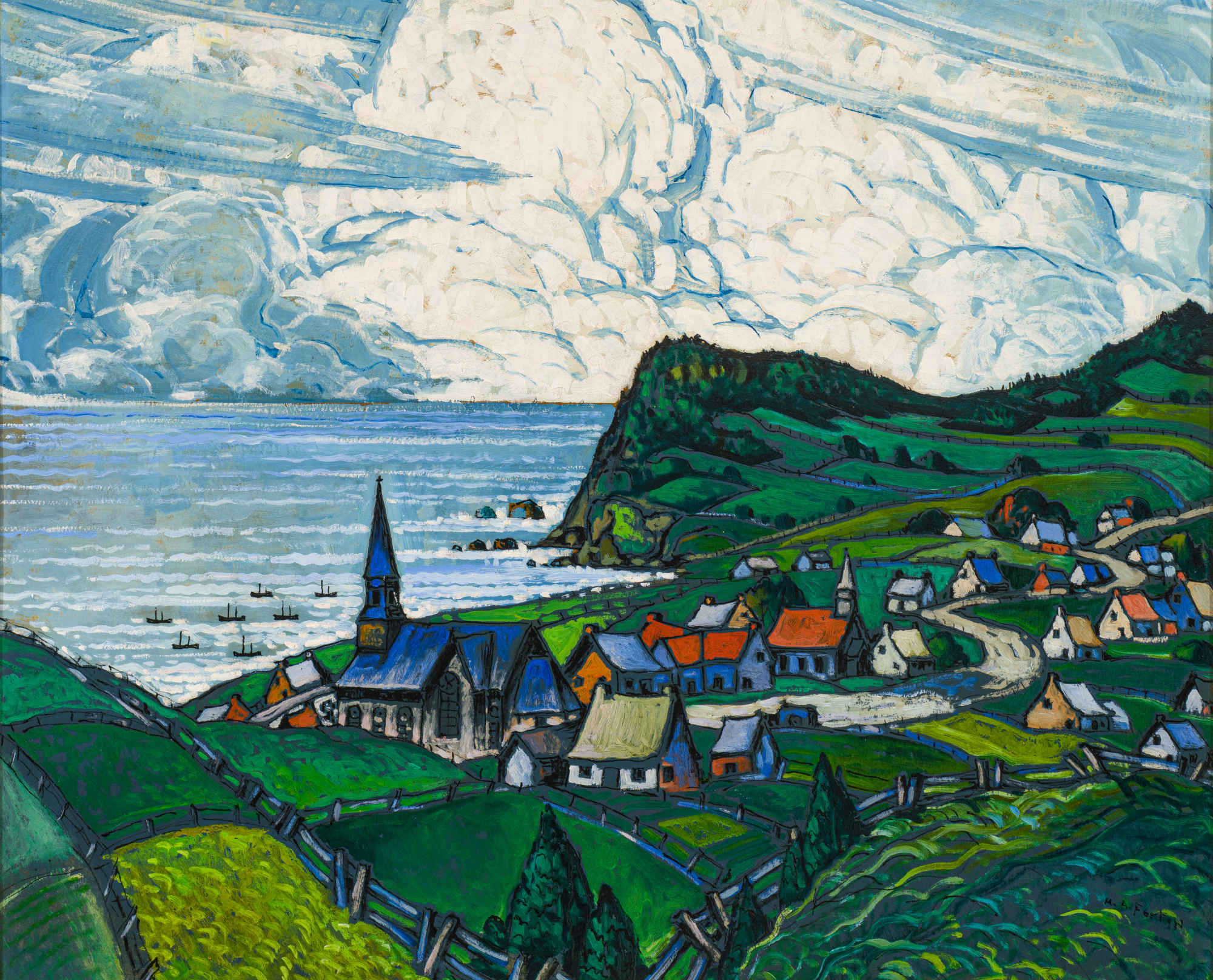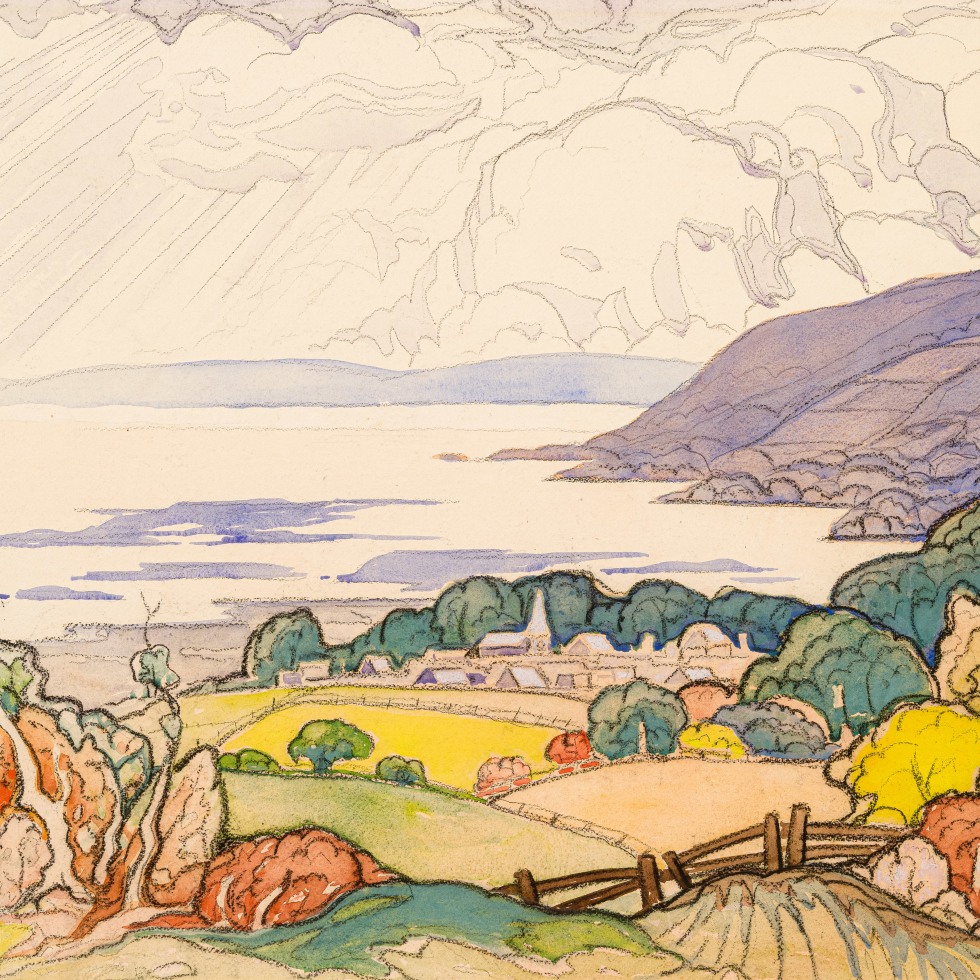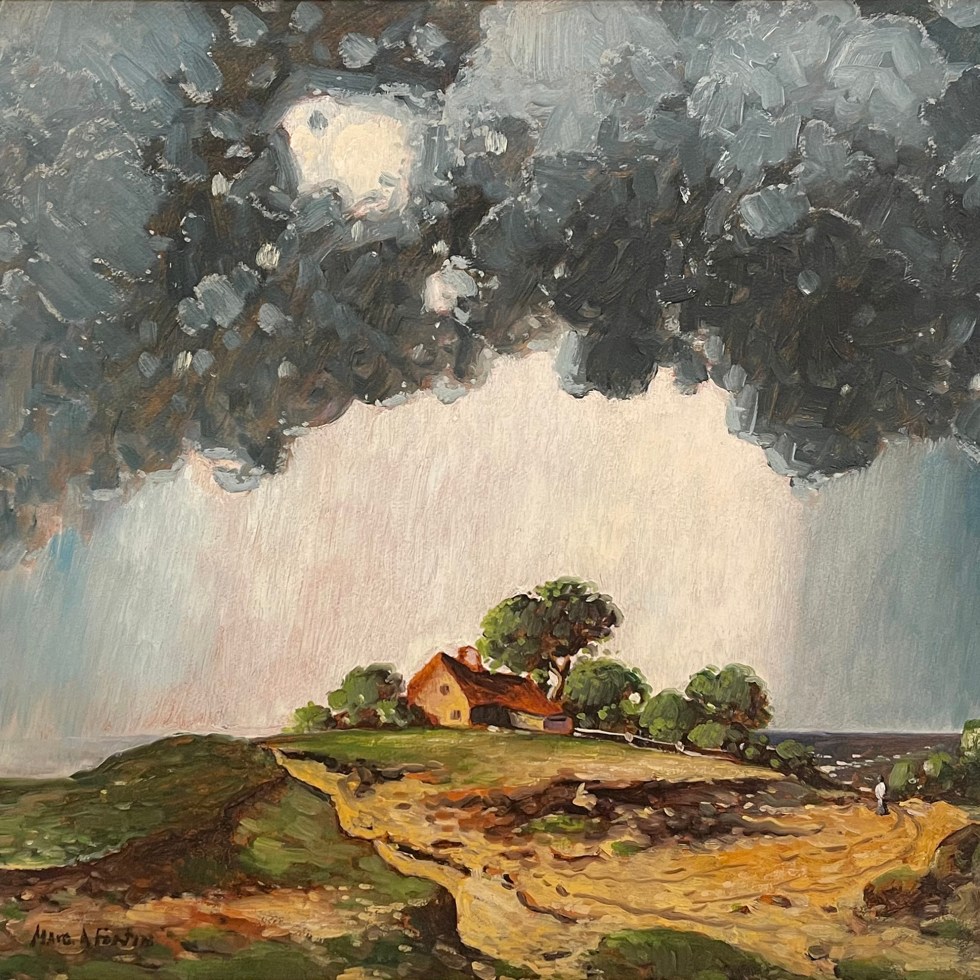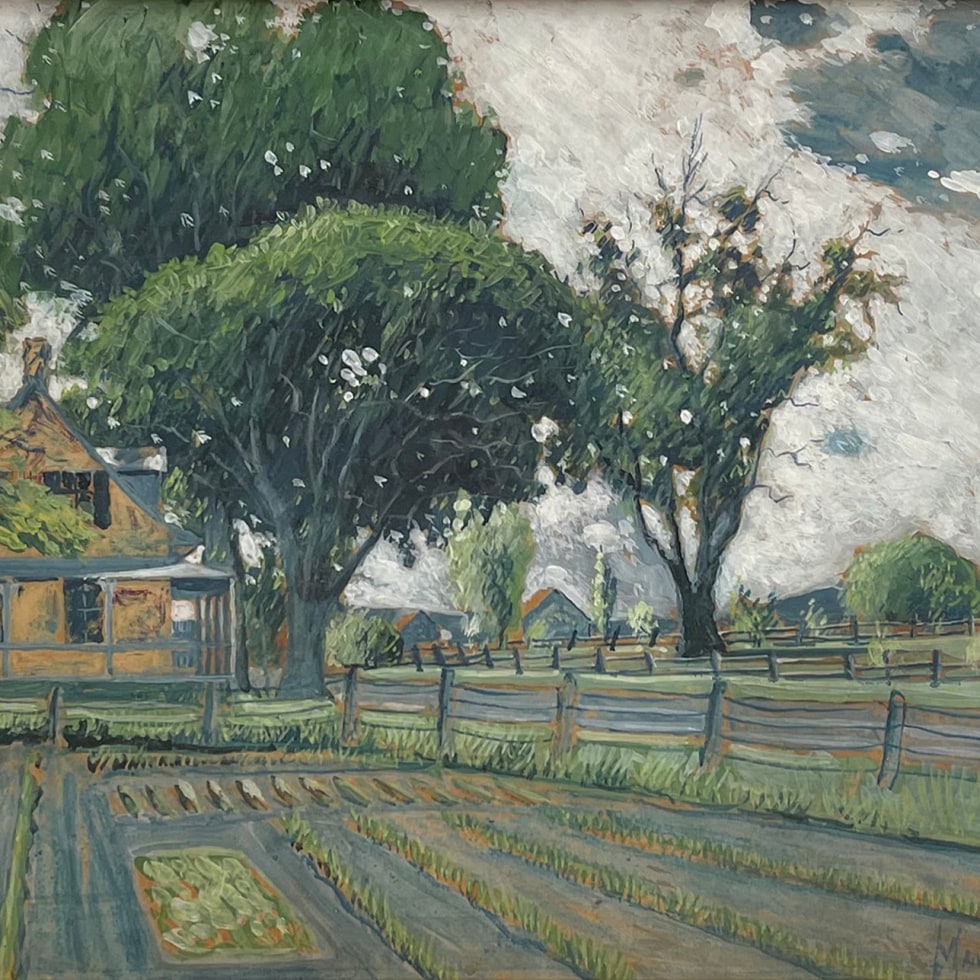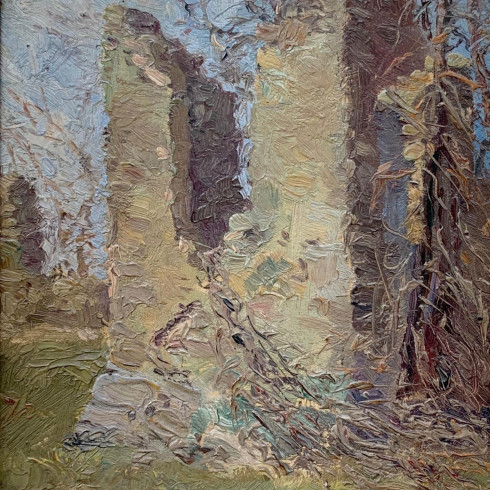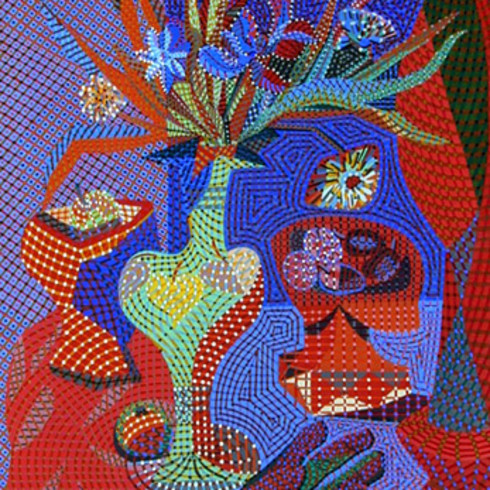Ventes notoires
Gaspé Peninsula Landscape, Anse-aux-Gascons, 1944 or 1945
96.5 x 116.8 cm
Inscriptions
signed, ‘M.A. Fortin’ (lower right)Provenance
Private collection, Montreal
Galerie Walter Klinkhoff Inc., Montreal
Montréal Trust Company, Montreal
Property of a Distinguished Montreal Collector, 1987
Expositions
Montreal, Art Association of Montreal, Sixty-sixth Exhibition of the Royal Canadian Academy of Arts, 2 November - 2 December 1945, cat no. 74.
Montreal, Galerie Walter Klinkhoff Inc., Marc-Aurèle Fortin Retrospective Exhibition, 8-22 September 1979.
Montréal, Musée Marc-Aurèle Fortin, 21 February- 24 April 1987.
Montreal, Galerie Walter Klinkhoff Inc., Marc-Aurèle Fortin (1889-1970): Retrospective Exhibition, 16-30 September 2006, cat. no. 39.
Quebec City, Musée national des beaux-arts du Québec, Marc-Aurèle Fortin. The Experience of Colour, 10 February - 8 May 2011, cat no. 96; also presented in Kleinburg, Ontario, at the McMichael Canadian Art Collection, 28 May - 11 September 2011, cat. no. 96.
Documentation
François Gagnon, “L’exposition annuelle de l'Académie royale”, La Presse, Montreal, 3 November 1945.
Anonyme, “Le village au bord des flots”, La Presse, Montreal, 8 November 1945, p.4 [reproduced].
Richard Foisy, François-Marc Gagnon, Michèle Grandbois, Sarah Mainguy, Esther Trépanier, Marc-Aurèle Fortin. The Experience of Colour, edited by Michèle Grandbois (Quebec City / Montreal, Musée national des beaux-arts du Québec : Les Éditions de l’Homme, 2011), 169, 255 [reproduced].
Marc-Aurèle Fortin was a prolific painter who created several thousand artworks during his career. Art dealer Walter Klinkhoff, who knew him well, described Fortin as a restless artist who painted obsessively. [1] A solitary, independent, and bohemian man, Fortin was not inclined to manage his work, even if only to date or sign his pieces. But he was eager to share his art and its evolution with the public. He exhibited his work frequently and regularly, participating in an impressive 165 exhibitions over the course of his life. Upon his return from Chicago, where he briefly studied at the Art Institute (1909–1910), Fortin’s work was selected to be displayed in two prestigious Canadian art shows: the annual exhibition of the Royal Canadian Academy of Arts (RCA) and the spring exhibition of the Art Association of Montreal (AAM, now the Montreal Museum of Fine Arts). These early signs of support were followed by many more, so much so that between 1910 and 1954, art enthusiasts could diligently follow the painter’s progress on the museum’s walls, as well as in public and private galleries throughout the city.
Major Canadian museums acquired works by Marc-Aurèle Fortin: the National Gallery of Canada in 1930, the Art Gallery of Toronto in 1935, and the Musée de la Province de Québec in 1937. A dynamic program of Canadian art exhibitions created by the National Gallery of Canada and held from the 1940s onward supported Fortin’s influence at home and abroad. In fact, the Gallery organized a major retrospective of Fortin’s work in 1964, bringing together some 110 paintings, watercolours and prints in an exhibition that opened in Ottawa and later travelled to Montreal, Quebec City, Regina, and Windsor.
Fortin’s active participation in the exhibitions of his time helped art historians establish the chronology of his many undated works. The presence of the sensational Gaspé Peninsula Landscape, Anse-aux-Gascons at the Sixty-Sixth Annual Exhibition of the Royal Canadian Academy of Arts in the fall of 1945 means it can be dated to 1944 or 1945. This is because the RCA’s fall exhibition, just like the AAM’s spring exhibition, only presented the most recent artworks of the selected artists, and it was during these last two years of World War II that Fortin completed his exploration of the Gaspésie region, which he preferred, even when he started visiting Saguenay in 1946. As of the spring of 1942, the public was able to see Fortin’s Gaspésie works at the annual exhibitions of the RCA and the AAM. It was not until 1944, however, that the toponym Anse-aux-Gascons was identified in the title of the painting. [2]
In the early 1940s, Fortin devoted himself to the “extraordinary” [3] landscapes of the southern shore of the Gaspé Peninsula along the Gulf of St. Lawrence, from Percé to Port-Daniel, particularly in Chandler and Anse-aux-Gascons, north of the Baie-des-Chaleurs. Of Anse-aux-Gascons alone, we know of eight large paintings, six watercolours and one pastel. [4] Most of them show a bird’s-eye view of the town, nestled in the curve of the bay, looking towards the point that extends into a sea teeming with reefs. The rocky cape, crowned by tall trees and covered in lush greenery, plunges sharply into the water. It is a strong, persistent image in the collective imagination of Anse-aux-Gascons, as painted by Fortin. So much so that simply searching the name of the Gaspesian town on the Internet immediately brings up one of the artist’s landscapes, rather than a photograph of the area.
In contrast to other known versions, this artwork—painted on a grey background—is distinguished by the demarcation of two equivalent chromatic zones. The green mass of the coastline is balanced out by the blue of the sky and the sea, creating an effect of stability. The relatively calm sea and the orderly arrangement of seven cod fishing schooners anchored in the cove contribute to this effect. However, nothing is permanent in a painting by Marc-Aurèle Fortin. Upon observing this stability, the peaceful feeling disappears, only to be replaced by the turbulent movement of the heavily clouded sky. The feeling is transformed once again when looking at the town and the farmland, which form a vivid pattern of saturated colours. The bold strokes that outline the motifs are typical of Fortin’s more blunt style, which he adopted in the 1940s. The town of Anse-aux-Gascons is easily recognizable, with the spires of the Catholic and Anglican churches rising above the small houses with sloped roofs. But beyond the depiction of the town, Fortin shows us a harmony of pictorial effects that bring together humanity and the raw forces of Canadian nature.
Michèle Grandbois
Michèle Grandbois is currently an independent art historian. She holds a doctorate in history from the Université Laval, and she taught art history before moving to the Musée national des beaux-arts du Québec (MNBAQ) in 1987 as curator of the museum’s collection of works on paper and then of its collection of modern art. She retired from the museum in 2014.
In addition to her activities in documentation, public representation, and expansion of the MNBAQ collections, Grandbois coordinated, directed, or co-directed some thirty exhibitions during her time as curator. She is the author of numerous monographs on Canadian artists, including Jean Dallaire, Clarence Gagnon, and Jean Paul Lemieux. Among her thematic writings are L’art québécois de l’estampe, 1945-1990 and (co-written with Anna Hudson and Esther Trépanier) The Nude in Modern Canadian Art, 1920–1950, winners in 1996 and 2011 respectively of the Award of Outstanding Achievement in Research from the Canadian Museums Association. She was general editor of the book Marc-Aurèle Fortin: L’expérience de la couleur (Marc-Aurèle Fortin: The Experience of Colour), which was awarded the Prix Marcel-Couture at the 2011 Salon du livre in Montreal. Her last project as curator of the MNBAQ was the exhibition Morrice and Lyman in the Company of Matisse, presented in Quebec City in the summer of 2014.
Always seeking deeper understanding and animated by her desire to create greater public awareness of art history, Michèle Grandbois now devotes herself to writing projects on Canadian modern art.
_________________________________
Footnotes:
[1] Walter Klinkhoff, “M.A. Fortin Remembered” in Richard Foisy, François-Marc Gagnon, Michèle Grandbois, Sarah Mainguy, Esther Trépanier, Marc-Aurèle Fortin. The Experience of Colour, edited by Michèle Grandbois (Quebec City / Montreal, Musée national des beaux-arts du Québec : Les Éditions de l’Homme, 2011), 288-291.
[2]In the catalogue, No. 16 is an oil painting titled L’Anse-aux Gascon, Gaspésie (Quebec City, Musée de la Province de Québec, Marc-Aurèle Fortin, ARCA, Adrien Hébert, RCA, Henri Hébert, RCA, Edwin H. Holgate, RCA, May 3–31, 1944). No. 121 and 122, respectively a watercolour and an oil painting, are titled Panorama sur l’Anse aux Gascons and Panorama sur l’Anse aux Gascons, dated 1942 (Montreal, Collège André-Grasset, Rétrospective Fortin, October 29-November 7, 1944).
[3]Letter from Marc-Aurèle Fortin to Jean-Paul Pépin. Drawing of the southern shore of the Gaspé Peninsula by Fortin, 1941, private archives of Estelle Piquette-Gareau.
[4] Many thanks to Sarah Mainguy, author of the artist's catalogue raisonné, for sharing this information.



